
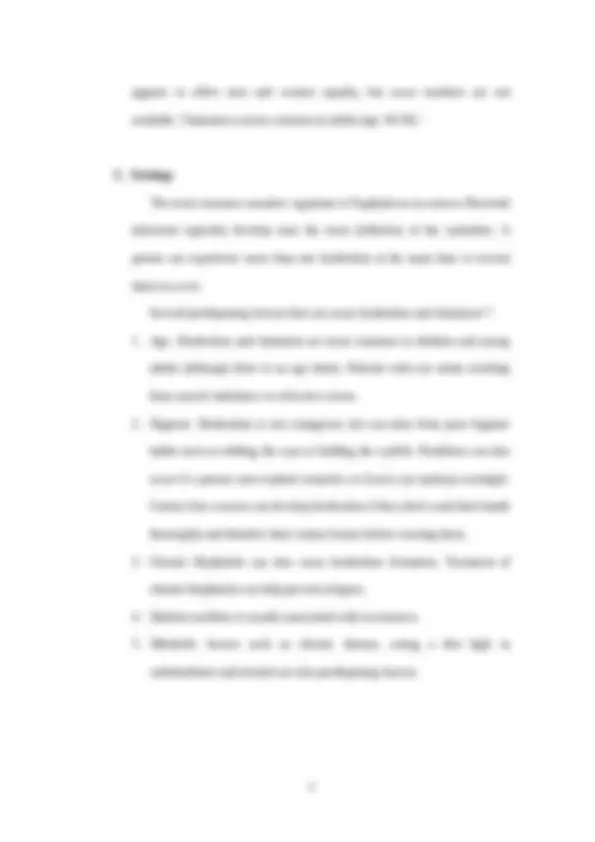
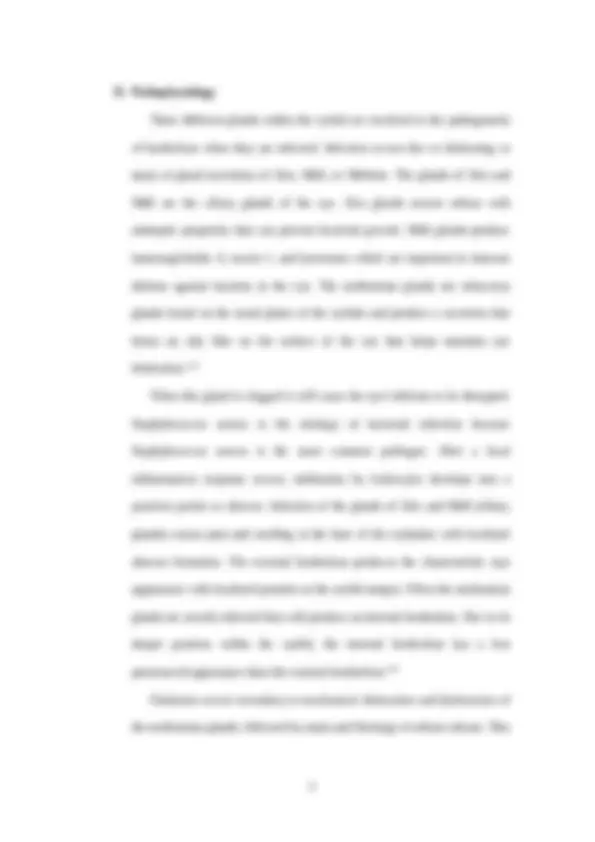
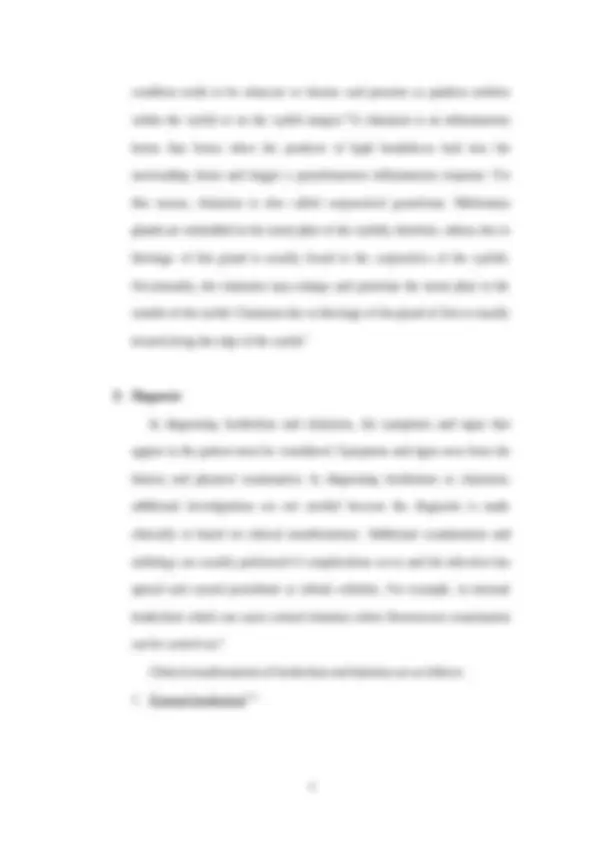
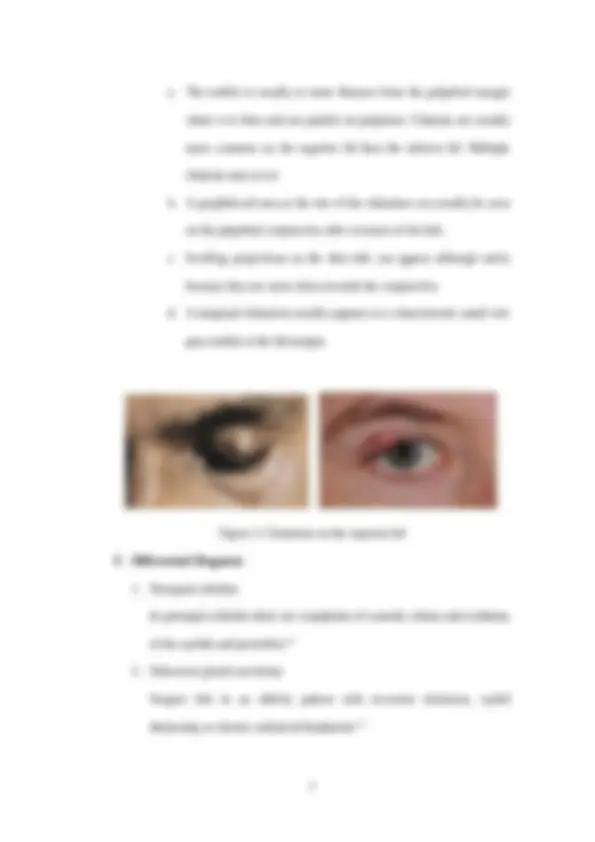
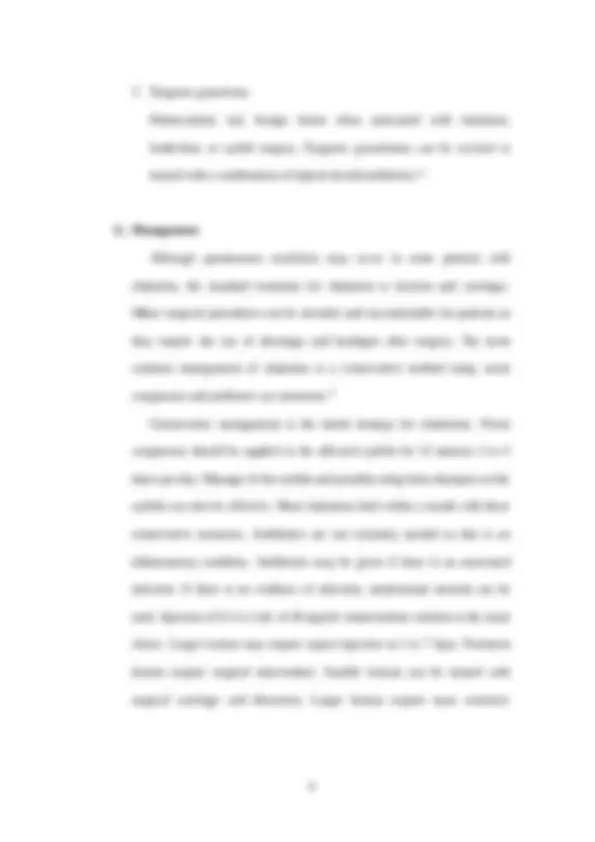
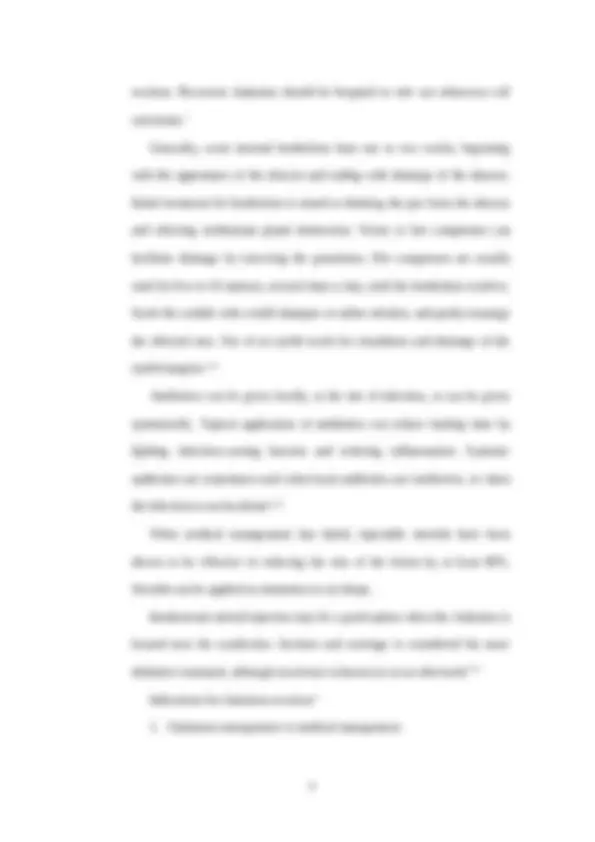



Study with the several resources on Docsity

Earn points by helping other students or get them with a premium plan


Prepare for your exams
Study with the several resources on Docsity

Earn points to download
Earn points by helping other students or get them with a premium plan
Community
Ask the community for help and clear up your study doubts
Discover the best universities in your country according to Docsity users
Free resources
Download our free guides on studying techniques, anxiety management strategies, and thesis advice from Docsity tutors
Providing Summary about Calazion and Hordeolum
Typology: Essays (university)
1 / 13

This page cannot be seen from the preview
Don't miss anything!








A. Definition Hordeolum is an infection of one or more glands in the eyelids. When the meibomian glands are affected it is known as an internal hordeolum. Hordelum externa or commonly called "stye" is an infection of the glands of Zeis or Moll. External hordeolum is often mistaken for a chalazion.5, Chalazion is a chronic, focal and sterile inflammation of the eyelids caused by obstruction of the meibomian glands. Chalazion is also often referred to as chronic sterile lipogranuloma. Deep chalazion is caused by inflammation of the tarsal meibomian glands and superficial chalazion is caused by inflammation of the glands of Zeis. Kalazia is the plural form of chalazion. Chalazion is a benign and self-limiting condition although it can develop into chronic complications. Recurrent chalazion needs further examination to exclude the possibility of malignancy.5, B. Epidemiology Hordeolum is a condition that often occurs and often patients do not go to health services to check themselves. There is no direct correlation between race, sex, or gender with regard to the prevalence of hordeolum. Adults may be more susceptible due to increased sebum viscosity. Patients with conditions such as blepharitis, seborrheic dermatitis, rosacea, diabetes, and hypercholesterolemia are also at increased risk of developing hordeolum.^6 Chalazion is a common condition, although the exact number of occurrences either in the US or worldwide is not documented. Chalazion
D. Pathophysiology Three different glands within the eyelid are involved in the pathogenesis of hordeolum when they are infected. Infection occurs due to thickening or stasis of gland secretions of Zeis, Moll, or Meibom. The glands of Zeis and Moll are the ciliary glands of the eye. Zeis glands secrete sebum with antiseptic properties that can prevent bacterial growth. Moll glands produce immunoglobulin A, mucin 1, and lysosomes which are important in immune defense against bacteria in the eye. The meibomian glands are sebaceous glands found on the tarsal plates of the eyelids and produce a secretion that forms an oily film on the surface of the eye that helps maintain eye lubrication.6, When this gland is clogged it will cause the eye's defense to be disrupted. Staphylococcus aureus is the etiology of bacterial infection because Staphylococcus aureus is the most common pathogen. After a local inflammatory response occurs, infiltration by leukocytes develops into a purulent pocket or abscess. Infection of the glands of Zeis and Moll (ciliary glands) causes pain and swelling at the base of the eyelashes with localized abscess formation. The external hordeolum produces the characteristic stye appearance with localized pustules at the eyelid margin. When the meibomian glands are acutely infected they will produce an internal hordeolum. Due to its deeper position within the eyelid, the internal hordeolum has a less pronounced appearance than the external hordeolum.6, Chalazion occurs secondary to mechanical obstruction and dysfunction of the meibomian glands, followed by stasis and blockage of sebum release. This
condition tends to be subacute to chronic and presents as painless nodules within the eyelid or on the eyelid margin.^10 A chalazion is an inflammatory lesion that forms when the products of lipid breakdown leak into the surrounding tissue and trigger a granulomatous inflammatory response. For this reason, chalazion is also called conjunctival granuloma. Meibomian glands are embedded in the tarsal plate of the eyelids; therefore, edema due to blockage of this gland is usually found in the conjunctiva of the eyelids. Occasionally, the chalazion may enlarge and penetrate the tarsal plate to the outside of the eyelid. Chalazion due to blockage of the gland of Zeis is usually located along the edge of the eyelid.^7 E. Diagnosis In diagnosing hordeolum and chalazion, the symptoms and signs that appear in the patient must be considered. Symptoms and signs seen from the history and physical examination. In diagnosing hordeolum or chalazion, additional investigations are not needed because the diagnosis is made clinically or based on clinical manifestations. Additional examinations and radiology are usually performed if complications occur and the infection has spread and caused periorbital or orbital cellulitis. For example, in internal hordeolum which can cause corneal irritation where fluorescence examination can be carried out.^8 Clinical manifestations of hordeolum and kalazion are as follows:
a. The nodule is usually at some distance from the palpebral margin where it is firm and not painful on palpation. Chalazia are usually more common on the superior lid than the inferior lid. Multiple chalazia may occur. b. A purplish-red area at the site of the chalazion can usually be seen on the palpebral conjunctiva after eversion of the lids. c. Swelling projections on the skin side can appear although rarely because they are more often towards the conjunctiva d. A marginal chalazion usually appears as a characteristic small red- gray nodule at the lid margin. Figure 3. Chalazion on the superior lid F. Differential Diagnosis
excision. Recurrent chalazion should be biopsied to rule out sebaceous cell carcinoma.^7 Generally, acute internal hordeolum lasts one to two weeks, beginning with the appearance of the abscess and ending with drainage of the abscess. Initial treatment for hordeolum is aimed at draining the pus from the abscess and relieving meibomian gland obstruction. Warm or hot compresses can facilitate drainage by removing the granuloma. Hot compresses are usually used for five to 10 minutes, several times a day, until the hordeolum resolves. Scrub the eyelids with a mild shampoo or saline solution, and gently massage the affected area. Use of an eyelid scrub for cleanliness and drainage of the eyelid margins.2, Antibiotics can be given locally, at the site of infection, or can be given systemically. Topical application of antibiotics can reduce healing time by fighting infection-causing bacteria and reducing inflammation. Systemic antibiotics are sometimes used when local antibiotics are ineffective, or when the infection is not localized.2, When medical management has failed, injectable steroids have been shown to be effective in reducing the size of the lesion by at least 80%. Steroids can be applied as ointments or eye drops. Intralesional steroid injection may be a good option when the chalazion is located near the canaliculus. Incision and curettage is considered the more definitive treatment, although recurrence is known to occur afterward.2, Indications for chalazion excision:^3